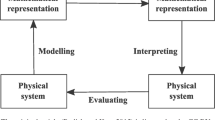Abstract
I examine the association between the observable physical world and the mathematical models of theoretical physics. These models will exhibit many entities that have no counterpart in the physical world, but which are still necessary for the mathematical description of physical systems. Moreover, when the model is applied to the analysis of a physical system, it will sometimes produce solutions that are unphysical—i.e. describe a physical system that simply cannot exist in the real world. It is argued that this poses a problem for the epistemic position of realism in physics: a mathematical theory that professes to give a correct description of physical reality should not contain such unrealistic objects. Some concrete examples are examined, and their implications for physics are discussed from a relativist epistemic perspective. I argue that the appearance of the unphysical entities and solutions also has significance for the teaching of physics. It is recommended that the students be exposed from the start to a relativist ontology, as advocated by the theory of radical constructivism; here the unphysical objects do not pose an epistemic problem.
Similar content being viewed by others
References
da Costa, N., & French, S. (2003). Science and partial truth: A unitary approach to models and scientific reasoning. Oxford: Oxford University Press.
Gödel, K. (1949). An example of a new type of cosmological solution of Einstein’s field equations of gravitation. Reviews of Modern Physics, 21, 447–450.
Hawking, S. W. (1992). Physical Review D: Particles and Fields, 46, 603–611.
Penrose, R. (2004). The road to reality. Vintage Books.
Pincock, C. (2010). The applicability of mathematics. Internet Encyclopedia of Philosophy.
Quale, A. (2008). Radical constructivism, a relativist epistemic approach to science education. Rotterdam/Taipei: Sense Publishers.
Rohrlich, F. (2007). Classical charged particles (3rd ed.). World Scientific Publishing Company.
Thorne, K. S. (1993). Closed timelike curves. Lecture given at the 13th international conference on General Relativity and Gravitation, Caltech Preprint GRP-340, 21 pp.
Weinberg, S. (1993). Dreams of a final theory. Random House.
Wheeler, J. A., & Feynman, R. P. (1949). Classical electrodynamics in terms of direct interparticle action. Reviews of Modern Physics, 21, 425–433.
Wigner, E. (1960). On the unreasonable effectiveness of mathematics in the natural sciences. Communications in Pure and Applied Mathematics, 13(1).
Author information
Authors and Affiliations
Corresponding author
Additional information
Based on a presentation given at the Nordic Symposium on Philosophy and History of Science in Science Education, Helsinki 2009.
Rights and permissions
About this article
Cite this article
Quale, A. On the Role of Mathematics in Physics. Sci & Educ 20, 359–372 (2011). https://doi.org/10.1007/s11191-010-9278-3
Published:
Issue Date:
DOI: https://doi.org/10.1007/s11191-010-9278-3




